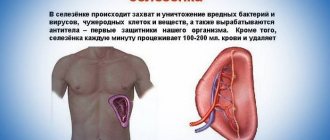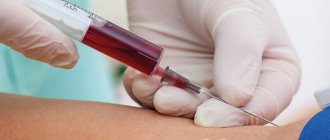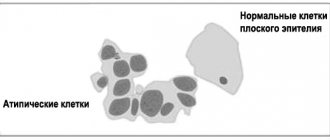What is the thyroid gland and what functions is it responsible for?
The thyroid gland (synonym: thyroid gland) is a primary internal secretion organ (endocrine gland), located in the front of the throat behind the thyroid cartilage (it is like a small butterfly that lives in the middle of everyone’s neck). Its main function is to manage your metabolism, producing the two most important hormones for the body, thyroxine and calcetonin, which affect:
- protein, energy and fat metabolism;
- cardiovascular system (CVS);
- central nervous system (CNS);
- reproductive and reproductive system;
- strength of bones, hair, nails and skin.
A malfunction of the endocrine gland affects a person’s appearance and well-being; in the absence of timely treatment, it entails a number of pathologies of the organ systems associated with it. Therefore, it is extremely important not to ignore the symptoms of thyroid disease and immediately seek help from a qualified doctor who will tell you how to treat the detected thyroid disease.
Get your thyroid tested
If you have one or more of these symptoms and you suspect the cause is a problem with the thyroid gland, then consult your doctor and ask for tests for thyroid-stimulating hormone (TST), free triiodothyronine (fT3), free thyroxine (fT4), and do an ultrasound of the thyroid gland - says Dr. Miller. Based on test results, symptoms and examination, you may be prescribed synthetic hormones. Testing and prescribing treatment for thyroid disease can involve some trial and error, so be prepared to visit your doctor several times to ensure the correct dosage is prescribed.
What thyroid diseases are there?
It turns out that thyroid problems are incredibly common. Thyroid disease affects 30 million people in the United States, and some experts estimate that thyroid disease could affect nearly 56 million Americans, let alone Russia due to radiation exposure from the Chernobyl nuclear power plant.
Note that "thyroid disease" is actually an umbrella term for several different conditions that can affect this gland, including:
- hypothyroidism;
- hyperthyroidism;
- autoimmune thyroid disease, which includes Graves' disease and Hashimoto's disease
- goiter, in which the thyroid gland enlarges in size;
- thyroid cancer;
Treatment of thyroid diseases
The endocrinologist decides how to treat the thyroid gland. Self-treatment or the use of traditional methods once the diagnosis has been established is excluded. For hypothyroidism and hyperthyroidism, the thyroid gland is treated with hormone-based medications.
Hormones are produced in varying amounts depending on the time of year, and symptoms are worse in winter. If tablets are prescribed for treatment (for example, eutirox), check whether the dose of the medicine needs to be increased in winter. Such medications are usually taken for a very long time, from six months. Often, drugs for the treatment of the thyroid gland in women are prescribed for life.
Introducing hormones from outside must be very careful. Therefore, listen to the advice of your endocrinologist about the gradual introduction of the drug, do not try to speed up the result.
We also recommend viewing: The process of complete or partial removal of the thyroid gland
Causes of thyroid disease
Currently, people are surrounded by hundreds of factors that affect their health in different ways. Many of them are capable of causing certain deviations. Therefore, in most cases it is very difficult to determine which of them became the objective causes of thyroid disease.
- Stress awaits a modern person everywhere: responsible and nervous work, problematic family relationships, a difficult economic situation. All this leads to dysfunction of the endocrine glands. The thyroid gland is the first to suffer, its tissues weaken and collapse. The amount of hormones it secretes changes, and their deficiency or excess depresses almost all vital systems of the body.
- The poor environmental situation in the region and the increased content of toxic substances in the air (mercury, benzene, nitrates) lead to the death of sensitive thyroid tissue. They are unable to recover, so the remaining living cells have to work hard and grow in volume.
- Diabetes: Experts estimate that about 30% of people with diabetes suffer from thyroid disease. Diabetes itself does not cause problems with the thyroid gland, but those who suffer from autoimmune type 1 diabetes are automatically at increased risk of other diseases, including this organ.
- The state of pregnancy is not considered a disease, but the female body feels overloaded during this difficult period. In order for the organs of the endocrine system to provide everything necessary not only to the child, but also to the mother, it is necessary to lead a healthy lifestyle, monitor nutrition, follow a regimen and drink vitamins.
- Problems of the gastrointestinal tract lead to a decrease in the absorption of nutrients, including iodine, which provokes the growth of goiter.
- Injuries: various injuries to the endocrine gland cause the inability to produce hormones in the amount necessary for the full functioning of the body, which is overgrown with scar and connective tissue.
- Lack of vitamins and minerals in the diet , exhausting diets - all this negatively affects the endocrine system.
- A tumor of the hypothalamus, pituitary gland of the thyroid gland , even if it is benign, gives the brain signals that there is a lack of hormone in the body. The organ begins to work harder and produces hormones in excess quantities, and their excessive quantity affects the body just as bad as insufficient.
State of thyroid activity and diseases caused by it
Thyroid diseases in women are largely related to the state of activity of the gland itself. The functional activity of the thyroid gland is divided into three main types, which must be considered separately.
Euthyroidism
In this condition, normal production of the hormones triiodothyronine and thyroxine and their excretion are noted.
At the same time, the systems and organs affected by the thyroid gland continue to function properly.
Thyroid disease in this case concerns primarily this organ of the female body and is not caused by a violation of hormone synthesis.
In such a situation, pathologies can be expressed in the form of nodes, hyperplasia, and so on.
Hypothyroidism
In this case, there is a lack of thyroid hormones, which can provoke a disruption of metabolic processes (certain or all) in specific systems under the control of the gland. Hypofunction is accompanied by energy deficiency.
Hyperthyroidism
This is the opposite of the previous condition, with it there is excessive activity of the thyroid gland, which indicates a malfunction in its functioning.
At the same time, an increased amount of hormones is released into the blood, as a result of which an increase in metabolic processes is observed in specific systems.
Also, an increase in the production and excretion of hormones is called thyrotoxicosis.
Important!
The anterior part of the pituitary gland secretes thyroid-stimulating hormone, which is responsible for the activity of the thyroid gland. Thus, it is its indicators that often indicate diseases of the thyroid gland: as a rule, an increase in it indicates hypothyroidism, and a decrease, on the contrary, indicates hyperthyroidism.
We recommend you find out: Is it possible to treat endocrine diseases without hormones?
Autoimmune diseases and various tumors and malignant neoplasms should be included in separate groups of thyroid pathologies.
List of thyroid diseases in women: symptoms, how dangerous they are and how to treat them?
Hypothyroidism
Hypothyroidism is the production of insufficient amounts of hormones by the thyroid gland. Signs of the disease in women are ambiguous and, if not properly diagnosed, can lead to a false diagnosis:
- asthenia (asthenic syndrome or chronic fatigue syndrome);
- unreasonable mood swings;
- increased sensitivity to cold
- swelling of the limbs;
- sudden and unreasonable change in body weight in any direction;
- fragility and dryness of hair, nails and skin;
- low blood pressure;
- vomiting, nausea;
- high cholesterol;
- decreased performance, partial memory loss;
- irregular menstrual cycle, decreased functions of the reproductive system, menopause;
- periodic changes in heart rate;
- heart murmur.
Diagnosis and treatment of hypothyroidism
The doctor will order blood tests to measure your TSH levels and thyroid hormone levels. Hypothyroidism is treated with hormone replacement therapy, that is, taking thyroid hormones. Early detection of thyroid disease is extremely important in the effectiveness of treatment; symptoms can be eliminated quickly enough.
Hypothyroidism is treated by taking a synthetic analogue of the missing hormone thyroxine. In most cases, therapeutic hormonal therapy is lifelong. A person's lifestyle plays an important role Proper nutrition, fresh air, and lack of stress will greatly facilitate recovery. The advanced stage of hypothyroidism leads to severe complications: swelling of internal organs and myxedematous coma (symptoms in women are minimal body temperature, almost complete absence of breathing and heartbeat).
Hyperthyroidism (thyrotoxicosis)
Thyrotoxicosis is a state of hyperfunction of the thyroid gland, when it produces an excess amount of thyroid hormones for the normal functioning of the body. All metabolic processes are accelerated .
Main signs of the disease:
- hot temper and nervousness;
- weight loss with a saturated diet;
- sleep problems;
- hot flashes, tendency to sweat, shortness of breath, thirst;
- gastrointestinal disorder (diarrhea, constipation, nausea);
- high blood pressure;
- frequent urination.
Often patients do not pay attention to these symptoms or associate them with diseases of other organs. With the deterioration of health and the progression of the disease, the most pronounced sign of thyrotoxicosis becomes noticeable - the eyeballs become bulging (see photo above).
Diagnosis and treatment of hyperthyroidism
During the diagnosis, blood is drawn and the levels of thyroid hormones (thyroxine or T4) and thyroid-stimulating hormone (TSH) are measured. High thyroxine levels and low TSH levels indicate an overactive thyroid gland.
Once the diagnosis is confirmed, the endocrinologist prescribes treatment with drugs that reduce the function of the secretion organs to produce hormones. The condition of most patients improves significantly within a month or two. After this, the dose of medication is reduced and gradually eliminated.
If the glands are greatly enlarged and drug treatment is powerless, the possibility of forcibly removing part of the tissue is considered. Surgical resection of the gland or injection of a radioactive isotope of iodine is possible, which leads to the natural death of approximately half of the cells.
Goiter (struma)
Goiter is a pathological increase in the size of the thyroid lobes as a result of excessive proliferation of its cells. As a rule, this occurs against the background of a deficiency or excess of the hormone thyroxine in the body. The reason is iodine deficiency. A goiter can form both with hypo- and hyperfunction of the secretion organs. Symptoms and signs are as follows:
- visual enlargement of the neck;
- feeling of discomfort, coma in the throat;
- difficulty swallowing and breathing;
- cough;
- cardiopalmus.
Diagnosis and treatment of struma
During a routine physical examination, the doctor feels your neck and asks you to swallow saliva. He also gives a referral for a blood test to determine the level of thyroid hormones, TSH and antibodies in the blood.
Treatment of each patient is a strictly individual process. Therapy is prescribed only by a doctor. Under no circumstances should you start treatment on your own without the results of an ultrasound examination and hormone analysis; you can greatly aggravate your health, and the consequences may be irreversible.
Hypothyroidism
Reduced production of hormones T3 and T4 leads to the disease hypothyroidism. This disease has two main causes: genetic predisposition and iodine deficiency. Signs of the disease:
- Tendency to be overweight (sometimes to lose weight);
- Plump hands. This phenomenon occurs due to subcutaneous edema. Such edema is not similar to renal edema; it cannot be “driven away” by taking diuretics;
- Swelling of the tongue - you can notice marks from the teeth along the edges of the tongue (the tongue does not seem to “fit” into the space allotted to it);
- Poor absorption of calcium, leading to brittle nails, dull hair, brittle bones, hair loss (hence the love for foods containing calcium - cheese, cottage cheese, fish and others);
- Irregular periods or amenorrhea;
- Tendency to blush on the cheeks;
- Tremor of the hands and eyelids;
- Increased body temperature (36.8-37) or chilliness;
- Dry skin, especially on the elbows;
- Irritability, short temper;
- Insomnia;
- Memory problems, absent-mindedness;
- Increased heart rate at rest;
- Manifestation of shortness of breath, lack of air;
- Diffuse toxic goiter;
- In progressive cases - enlargement of the eyeball, bulging eyes.
We also recommend viewing: Endorm for autoimmune thyroiditis: application features
Of course, a love of cheese or hysteria cannot be signs on the basis of which a doctor will make a final diagnosis. This requires blood tests for thyroid hormones. The basic test is to determine the level of TSH, then free T3 and T4, antibodies to TPO, total T3 and T4 are determined.
How to prevent thyroid problems
In most cases, hypothyroidism or hyperthyroidism cannot be prevented. In developing countries, hypothyroidism is often caused by iodine deficiency. However, thanks to the addition of iodine to table salt, this deficiency is rare in Russia. But still, endocrinologists strongly advise following simple rules:
- provide the body's daily need for iodine - from 50 to 100 mcg;
- quitting smoking and drinking alcohol;
- lack of stress;
- varied diet;
- physical activity, morning exercises;
- annual examination by an endocrinologist.
Nutrition must necessarily include berries, vegetables, fruits, nuts, root vegetables, herbs, shrimp, fish, crabs, algae, honey, cereals, cereals and legumes.
You should completely or at least partially abandon:
- sausages;
- flour and confectionery products;
- coffee;
- carbonated drinks;
- everything fried, smoked, canned;
- eggs;
- ketchup, mayonnaise, vinegar, hot seasonings.
If you notice signs of thyroid disease, you can’t wait; you need to urgently visit a doctor and start therapy. The initial stage is easy to treat and does not imply disturbances in the human hormonal system, on which the health of the entire organism depends.
Goiter
Trying to compensate for the lack of hormones, the body increases the size of the thyroid gland. Goiter (another name is struma) can occur with both decreased and increased thyroid function, as well as with normal hormone levels (euthyroidism).
A goiter is a consequence of the growth of the thyroid gland, and not a tumor or inflammation. Goiter has several main varieties, among them:
- Diffuse goiter - growth of the thyroid gland without nodes in its tissues;
- Nodular goiter - enlarged thyroid gland with nodes;
- Autoimmune thyroiditis.
A goiter has different stages, it may not be noticeable at all, or it can grow to enormous sizes and be visible to the naked eye, and then it causes serious trouble because it compresses the larynx.
The most common endemic goiter in the world is caused by iodine deficiency. The second most common is Hashimoto's goiter (in 3.5% of the world's population), caused by autoimmune processes in the body. This disease occurs in women 6 times more often than in representatives of the stronger half of humanity. The main reason is genetic predisposition. Visually pronounced Hashimoto's goiter most often occurs in women over 60.
In addition to an increase in the size of the thyroid gland, goiter will have those signs that are characteristic of the condition that accompanies it - thyrotoxicosis or hypothyroidism.
Treatment in most cases is medication. If it is insufficient, partial (resection of the node) or complete removal of the thyroid gland is prescribed. After partial removal, the patient leads a normal life; with complete removal, he is prescribed lifelong hormonal therapy, which amounts to daily intake of the hormone in pill form.
Ultrasound of the thyroid gland
In case of goiter, an ultrasound scan of the thyroid gland is prescribed, which can show the presence of nodes that are manifestations of a colloid or nodular form of goiter, a cyst, autoimmune functioning of the hormonal system, or oncology. At the discretion of the doctor, a biopsy may be prescribed. How to treat the thyroid gland in women with signs of the disease such as nodes depends on their size. If the node is not a malignant tumor and measures less than 1 cm, it is simply observed.
We also recommend viewing: Necessary products for normal thyroid function
Main symptoms
Symptoms of thyroiditis are felt already during the development of the disease; in the initial stages, it is difficult to determine the pathology without special studies. Such reactions manifest themselves as follows:
- Changes in weight, there may be an increase or a sharp decline.
- Soreness, swelling of the throat, sometimes a cough or a sore feeling.
- Enlargement of the thyroid gland, sometimes it is noticeable even visually without palpation, a goiter may appear.
- Weakness, high fatigue.
- Failure of the menstrual cycle, reproductive disorders.
- Changes in blood pressure.
- Unreasonable mood swings, emotional excitability or apathy.
Signs can appear with varying intensity; each type of thyroiditis has characteristic symptoms.
Symptoms for a specific type of inflammation
Acute thyroiditis is characterized by an increase in temperature, both general for the whole body and in a specific area of the thyroid gland. If tissue suppuration is present, the temperature approaches 40°C, the person shudders, and severe pain occurs in the neck, back of the head, ears, and tongue.
Subacute thyroiditis also occurs with elevated temperature, on average up to 39°C. Central nervous system disorders, headaches, as well as discomfort in the neck and ear are observed, which increase during eating. Feeling of heaviness in the thyroid area, profuse sweating, tremors of the limbs.
Chronic thyroiditis , and in particular autoimmune thyroiditis, manifests itself in the form of diffuse enlargement of the thyroid gland, heart rhythm disturbances, and problems with swallowing, as there is a feeling of a “lump” in the throat. Weight changes rapidly, although appetite remains the same. The gland may become denser and tuberosity may appear.
It is impossible to independently analyze the symptoms and make a conclusion; only an endocrinologist, after diagnostic measures, is able to determine the type of disease.
How to recognize euthyroidism?
In clinical practice, euthyroidism is considered a normal variant, but without careful monitoring, this condition may well lead to the formation of a goiter or a cancerous tumor.
If the pathological process is not accompanied by an enlargement of the thyroid gland, there are no symptoms of the disease.
When a goiter forms, compression of nearby organs occurs, the disease manifests itself as follows:
- external defect on the front surface of the neck;
- neck fatigue;
- hoarseness and hoarseness of voice;
- dry cough;
- dysphagia (difficulty swallowing food).
The initial visit to an endocrinologist in 95% of cases is associated with an aesthetic defect; other symptoms are ignored in most cases.
The presence of such manifestations indicates an advanced pathological process; malignancy is possible - the transformation of a goiter into a cancerous tumor.
Euthyroidism
This is one of the most difficult lesions of the thyroid gland to diagnose, since very often it occurs in a latent form. In the initial stages, its presence can only be detected using ultrasound.
Symptoms:
- causeless irritability;
- fatigue;
- slight swelling in the thyroid area;
- feeling of a lump in the throat.
Most often, treatment is prescribed with iodine-containing drugs; in severe cases, surgery is prescribed.
Problems with the thyroid gland can be caused by a whole range of endocrine diseases and have a negative impact on the body. If there is discomfort in the area of the gland and alarming symptoms, you should immediately seek medical help.
Article design: Vladimir the Great
Hashimoto's disease
Problems with the thyroid gland, the symptoms of which most often do not appear in the early stages, occur for various reasons. Hashimoto's disease is an autoimmune disease that leads to complete disruption of the structure and function of the thyroid gland. The pathology is chronic and slowly developing.
The immune system begins to produce antibodies against healthy gland cells. Most often, women over 30 years of age are susceptible to this disease. There are no symptoms of the disease in the initial stages, so it is diagnosed in advanced stages.
The main features include:
- fatigue;
- irritability;
- decreased performance;
- dry and cold skin;
- swelling;
- weight gain;
- poor cold tolerance;
- chills.
Treatment is carried out only with medications that normalize the level of hormones in the blood. Therapy most often lasts a lifetime.
Manifestations of thyrotoxicosis
Excessive production of thyroid hormones affects the activity of all organs and systems.
The following symptoms are typical:
- Psychoneurological symptoms: irritability, attacks of aggression, increased anxiety, depression, hysteria, panic attacks, drowsiness, memory impairment, headaches, dizziness.
- Reproductive disorders in women: decreased sexual desire, dysmenorrhea (irregular painful periods), amenorrhea (absence of the menstrual cycle), infertility.
- Reproductive disorders in men: decreased libido, impotence, gynecomastia (enlarged mammary glands).
- Cardiovascular symptoms: palpitations, tachycardia, arrhythmia, changes in blood pressure.
- Symptoms from the gastrointestinal tract: dyspeptic disorders, increased appetite, weight loss.
- Changes in the skin and appendages: fragility and hair loss, premature graying; fragile deformed nail plates; wet hot skin.
The clinical picture of hyperthyroidism also includes general symptoms: increased sweating, fever, trembling, muscle spasms and cramps, fatigue, general weakness.
If thyrotoxicosis was not diagnosed in the early stages, exophthalmos (bulging eyes) develops.
The appearance of this symptom is characteristic of an autoimmune disease called Graves' disease and is associated with the uncontrolled production of thyroid hormones. This condition requires immediate treatment.
Graves' disease
This is one of the most famous thyroid diseases. In different medical sources it has different names - diffuse toxic goiter, Graves' disease and Flayani's disease. The age of the disease is quite “young” - 20-40 years. Most often, this pathology affects women.
Symptoms:
- insomnia;
- nervousness;
- arrhythmia;
- tremors in the hands;
- increased sweating;
- disruption of the gastrointestinal tract;
- lack of sexual desire;
- bone fragility;
- chest pain;
- shortness of breath;
- eye damage.
Treatment of Graves' disease begins with hormonal medications, which will need to be taken for up to 2.5 years. If drug treatment does not help, then surgery or radioisotope therapy is used.
How to identify problems yourself
You can try to determine problems with the thyroid gland (the symptoms are described in detail above) on your own, but you should remember that only a doctor can make a correct diagnosis and prescribe adequate treatment. At home, diagnosis is carried out in two ways - visual and contact. The thyroid gland is located in the lower front part of the neck.
Direct signs of the presence of pathology include:
- noticeable expansion of the lower neck;
- there is slight redness on the skin;
- when swallowing there is no movement of the Adam's apple;
- when pressing on the area where the gland is located, pain appears;
- in rare cases, you can feel unnatural seals.
Indirect signs include:
- persistent feeling of hunger;
- swelling;
- chills;
- behavioral changes and other symptoms described above.
Prevention
Inflammation of the thyroid gland can be prevented by timely treatment of infectious and viral diseases. In order to prevent thyroiditis, it is recommended to lead a healthy lifestyle, avoid excessive physical activity and emotional stress. Those who have a genetic predisposition to diseases of the endocrine system need to undergo regular examinations to identify problems with the thyroid gland.
Causes and symptoms of hypothyroidism are a lack of thyroid hormones. Symptoms.
The first signs of benign formations
Swelling of the thyroid gland, or goiter, can be caused by either an excess or insufficient production of thyroid-stimulating hormones.
Most often, the right side of the gland enlarges the most, since by nature it is always slightly larger than the left.
The following factors can also be causes of goiter:
- smoking and alcoholism;
- infectious diseases;
- taking certain medications;
- hormonal changes in the body, which is more common in women;
- work in hazardous production;
- lack of vitamins and microelements in the diet.
In such cases, the contours of the neck often change, and a feeling of tightness in the throat appears. Goiter can occur against the background of autoimmune disorders.
For example, Hashimoto's goiter occurs against the background of attacks by immune cells on the glandular cells of the thyroid gland.
Benign formation
Important!
This disease can lead to the growth of the gland to gigantic proportions. Then doctors make a decision on surgical intervention and removal of the thyroid gland.
Hyperthyroidism
Problems with the thyroid gland, the symptoms of which are often similar to other diseases, occur due to the saturation of the blood with hormones. This leads to accelerated metabolism and hyperthyroidism. The peculiarity of this pathology is that young women are most often susceptible to it.
Symptoms:
- mental state disturbance (irritability, anxiety, etc.);
- malfunction in the cardiovascular system (arrhythmia, tachycardia, etc.);
- ophthalmological problems (erosions, swelling of the eyelids and others);
- critical weight loss;
- muscle pain and weakness;
- lack of sexual desire;
- disruption of the menstrual cycle;
- regular headaches;
- fainting.
Several methods are used to treat hyperthyroidism:
- drug therapy, in which antithyroid drugs are prescribed;
- surgical intervention is carried out only if there are neoplasms on the gland;
- radioiodine therapy, which consists of a single dose of a capsule with a medicine that helps reduce the size of the thyroid gland to normal.
Diagnostics
If you suspect thyroid disease, you should consult an endocrinologist who will prescribe all the necessary tests.
1. Palpation
This method allows you to determine the size and mobility of the gland. In addition, by palpation you can find out whether there is a goiter or tumors. At the same time, the lymph nodes are also examined, as they can be enlarged in the case of malignant tumors on the thyroid gland. The accuracy of this method is more than 60%.
2. Ultrasound
Using this study, the presence of a tumor is confirmed or refuted.
In addition, ultrasound determines:
- contours of the gland;
- uniformity of fabrics;
- the presence of inflammatory processes;
- gland structure.
3. Radiation diagnostics
This technique includes 2 types of research - computed tomography and radiography. Tomography helps determine the presence of a tumor and determine whether surgical intervention is necessary. In addition, with its help, the size and location of the tumor, the structure and shape of the organ are determined.
Using X-rays, not only the presence of tumors is diagnosed, but also the deposition of calcium salts.
4. Cytological examination
It is carried out only if the studies described above confirm the presence of neoplasms. During the procedure, local anesthesia is used.
5. Differential diagnosis
It is carried out by an endocrinologist together with other specialists if there is doubt about the diagnosis.
6. Scintigraphy
In this study, radioisotope substances are used. It is carried out if a cancerous tumor is suspected.
7. Biopsy
During this procedure, tissue is taken from the thyroid gland to determine if there are cancer cells in it.
8. Biochemical blood test
This analysis is carried out in several ways - radioimmune, luminescent, enzymatic. Using this study, the concentration of the hormone in the blood is determined.











